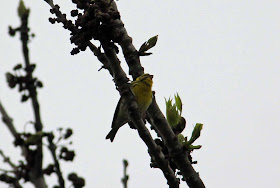Yesterday started overcast and thunderstorms were forecast
for the evening but the rest of the week looks even worse so I decided to make
the most of the day.
A Red-breasted Flycatcher (dvergfluesnapper) was reported on Monday from
Dælivannet close to Oslo so that was going to be my first stop. Before I had
even left the house though I had a message from Kjetil J that the Serin
(gulirisk) had returned for the fourth year running to Haslum Chuch which is
close to the flycatcher. Two good birds to go for!
The Flycatcher was singing when I got to its favoured area and sang for the
next 10 minutes but I failed to see it in the dense woodland even though it was
close. It then shut up for an hour and I was close to leaving when it sang
again and this time I located it. Inside the mixed spruce and deciduous wood it
was quite dark so the pictures are all with a high ISO. Also I continually
failed to capture it the few times it perched low down as the autofocus just
wouldn't lock on. A great bird though and only my second ever adult male. Also
in the area a singing, brown, first summer Common Rosefinch (rosenfink),
Hawfinches (kjernebiter) and a Lesser Spotted Woodpecker (dvergspett).
 |
| male Red-breasted Flycatcher (dvergfluesnapper) |
 |
| singing male Common Rosefinch (rosenfink). The brown as opposed to red plumage shows this to be a male in its second year (1st summer) |
After all this excitement the Serin gave itself up very easily although always sat very high up as it sang its little heart out.
 |
| singing male Serin (gulirisk) |
I paid my first visit to Maridalen for a few days and had a flock of 5 immature
Mute Swans (knoppsvane) and two Whooper Swans. A Rook (kornkråke) with a flock
of Crows (kråke) was my second record here this year but only my third ever on
the patch. This bird had an adult like bill so was different to the 1st summer
I had earlier this spring.
 |
| Rook (kornkråke) - a rare Oslo and Maridalen sighting |
 |
| another picture of that Wryneck (vendehals) |
 |
| ...and another |
A few Yellow Wagtails (gulerle) included a singing male and one of the Wrynecks
(vendehals) showed well.
In the early evening the sun shone but this was only a window of light before
the thunderstorms were to start. I never the less headed towards Hellesjøvannet
where a Great Reed Warbler (trostesanger) was heard on Monday. On the way I had
three Honey Buzzards (vepsevåk) and a Hobby (lerkefalk) over the road and it
looks like these late migrants are arriving in force. The Honey Buzzards showed
very well although I underestimated how much I needed to adjust the exposure
with the closest pictures. One bird was very pale and could almost suggest an
Osprey. Looking at the pictures all three appear to be males due to limited barring on the flight feathers and grey heads. At Tuentangen two male Red-backed Shrikes showed distantly but I got my
first picture of one for the year.
 |
| Hobby (lerkefalk) |
 |
| Honey Buzzard 1 an intermediate phase |
 |
| same bird as above |
 |
| pale phase Honey Buzzard (#2) |
 |
| #3, a dark phase bird, which was circling above #2. I assumed them to be a pair but it looks like both are males |
 |
| first Red-backed Shrike of the year burned onto the hard disk |
At Kjelle nine Temminck's Stints were nearly impossible to see feeding on a
distant area of mud and a singing Spotted Crake (myrrikse) was completely
impossible to see.
At Hellesjøvannet I had an hour before the heavens opened at 8pm. In this time
I heard three Reed Warblers (rørsanger) and one Sedge Warbler (sivsanger) and
saw a male and female Marsh Harrier. It then rained really hard for two hours
and it wasn’t until 10pm that I was able to get out of the car and have a
listen. Three singing Spotted Crakes was quite a result along with another
Sedge Warbler but no Great Reed.
Driving home there were countless flooded fields and in two
areas houses were flooded and people were standing outside getting assistance
from the fire brigade. On the radio they were saying that there is a risk of a 50
year flood in many parts of Southern Norway due to combined heavy rainfall and
melt water from the mountains.














No comments:
Post a Comment